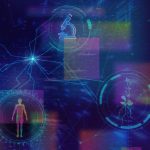Consciousness—the internal awareness that you exist—continues to captivate philosophers and neuroscientists alike. Insight into human consciousness can be gathered from the artificial intelligence (AI) language model ChatGPT. This trained computer chatbot can generate text, answer questions, provide translations, and learn based on the user’s feedback. Large language models like ChatGPT may have many applications in science and business, but how much do these tools understand what we say to them, and how do they decide what to say back? Professor Terrence Sejnowski explored the relationship between the human interviewer and language models to uncover why chatbots respond in particular ways, why those responses vary, and how to improve them in the future.
Read News ReleaseDiscoveries
Communications/
Nature
Biotechnology
Wearable microscopes advance spinal cord imaging in mice
The spinal cord acts as a messenger, carrying signals between the brain and body to regulate everything from breathing to movement. While the spinal cord is known to play an essential role in relaying pain signals, technology has limited scientists’ understanding of how this process occurs on a cellular level. Now, Associate Professor Axel Nimmerjahn; co-first authors Pavel Shekhtmeyster, Erin Carey, and Daniela Duarte; and colleagues have created wearable microscopes to enable unprecedented insight into the signaling patterns that occur within the spinal cords of mice. The lab’s technological advancement will help researchers better understand the neural basis of sensations and movement in healthy and disease contexts, such as chronic pain, itch, amyotrophic lateral sclerosis (ALS), or multiple sclerosis (MS).
Read News ReleaseNot all itches are the same, according to the brain
In addition to broader inquiry into consciousness, scientists also ask questions about neuron communication. Itch is a protective signal that animals use to prevent parasites from introducing potentially hazardous pathogens into the body. Itchiness due to something like a crawling insect is known as “mechanical” and is distinct from “chemical” itchiness generated by an irritant, such as a mosquito’s saliva if the mosquito were to bite a person’s arm. While both scenarios cause the same response (scratching), recent research by Professor Martyn Goulding, Associate Professor Sung Han, and colleagues has revealed that, in mice, a dedicated brain pathway drives the mechanical sensation and is distinct from the neural pathway that encodes the chemical sensation. Their findings open up new avenues for therapeutic interventions for patients who experience a range of chronic itch conditions, including atopic dermatitis and psoriasis.
Read News ReleaseMitochondria power-supply failure may cause age-related cognitive impairment
The brain is divided into areas, each containing many millions of neurons connected across thousands of synapses. These synapses, which enable communication between neurons, depend on even smaller structures: message-sending boutons (swollen bulbs at the branch-like tips of neurons), message-receiving dendrites (complementary branch-like structures for receiving bouton messages), and power-generating mitochondria. Professor John Reynolds, co-first authors Courtney Glavis-Bloom and Casey Vanderlip, and colleagues found that brains lose synapses as they age and the synapses that remain show a breakdown in coordination between the size of boutons and the mitochondria they contain. Their findings open an entirely new way of thinking about cognitive decline that could lead to new targets for future therapeutics.
Read News ReleaseHow aggression-promoting brain peptide works in fruit flies
Tiny proteins and molecules impact neuron communication to alter brain activity. In addition to communicating via chemicals called neurotransmitters, the brain also uses proteins called neuropeptides. Though their importance is widely recognized, the way neuropeptides move around the brain and influence neurons has remained poorly understood—until now. Associate Professor Kenta Asahina and colleagues have found the variable influence that neuropeptides can have on brain activity, which illuminates how the brain communicates in flies—an important step to understanding the underlying causes of human conditions, like autism spectrum or attention deficit disorders.
Read News ReleaseNew way to model human brain immune cells and neurological disorders
Situated at the intersection of the human immune system and the brain are microglia, specialized brain immune cells that play a crucial role in development and disease. Although the importance of microglia is undisputed, modeling and studying them has remained a difficult task. To overcome this barrier, Professor Rusty Gage, Associate Professor Axel Nimmerjahn, co-first authors Simon Schafer and Abed Mansour, and colleagues developed an organoid model—a three-dimensional collection of cells that mimics features of human tissues. This model allows researchers to study human microglial development and function for the first time in living human-derived tissue. The scientists also examined patient-derived microglia from children with a type of autism spectrum disorder to determine whether brain environment influences the development of more reactive microglia.
Read News ReleaseCracking the case of mitochondrial repair and replacement in metabolic stress
Professor Reuben Shaw has spent nearly two decades piecing together how the cell responds to metabolic stress, which occurs when cellular energy levels dip. Whether energy levels fall because the cell’s powerhouses (mitochondria) are failing or due to a lack of necessary energy-making supplies, the response is the same: get rid of the damaged mitochondria and create new ones. Now, Shaw, first author Nazma Malik, and colleagues crack the case on this process of removal and replacement, finding that a protein called FNIP1 is the critical link between a cell sensing low energy levels and eliminating and replacing damaged mitochondria. The finding has implications for better understanding healthy aging, cancer, neurodegenerative diseases, and more.
New drug combination reduces lung tumors in mice
Featured Stories
 Leading with Technology – Salk scientists develop new means of discoveryOur scientists continue to push technological limits to—among other things—store more excess atmospheric carbon in deeper plant roots, study pancreatic cancer more accurately, follow cellular activity in real time more clearly, and track all kinds of motion more easily.
Leading with Technology – Salk scientists develop new means of discoveryOur scientists continue to push technological limits to—among other things—store more excess atmospheric carbon in deeper plant roots, study pancreatic cancer more accurately, follow cellular activity in real time more clearly, and track all kinds of motion more easily. Dannielle Engle—Putting patients firstEngle, an assistant professor, has a deeply personal connection to pancreatic cancer that changed her career trajectory and made her want to focus on the disease. Inside Salk sat down with Engle to find out more about her dedication to finding better treatment options.
Dannielle Engle—Putting patients firstEngle, an assistant professor, has a deeply personal connection to pancreatic cancer that changed her career trajectory and made her want to focus on the disease. Inside Salk sat down with Engle to find out more about her dedication to finding better treatment options.
 Weiwei Fan—Life is energyFan, a staff scientist in Professor Ronald Evans’ lab, studies mitochondria because he feels drawn to understanding how these energy generators within our cells function and the natural variations that exist between individuals.
Weiwei Fan—Life is energyFan, a staff scientist in Professor Ronald Evans’ lab, studies mitochondria because he feels drawn to understanding how these energy generators within our cells function and the natural variations that exist between individuals. Natanella Illouz-Eliaz—Recipe for a plant biologist: tomatoes, failure, and perseveranceIllouz-Eliaz, a postdoctoral researcher in Professor Joseph Ecker’s lab, grew up in Israel near the border with Lebanon, where high-pitched sirens periodically drove her family into bomb shelters for safety. But her parents insisted that she get the best education possible.
Natanella Illouz-Eliaz—Recipe for a plant biologist: tomatoes, failure, and perseveranceIllouz-Eliaz, a postdoctoral researcher in Professor Joseph Ecker’s lab, grew up in Israel near the border with Lebanon, where high-pitched sirens periodically drove her family into bomb shelters for safety. But her parents insisted that she get the best education possible. Richard Heyman—From Salk to biotech and backHeyman, a scientist and entrepreneur who has founded numerous biotechnology companies, currently serves as vice chair of Salk’s Board of Trustees, but his Salk story actually began when he was a postdoctoral researcher in the lab of Professor Ronald Evans.
Richard Heyman—From Salk to biotech and backHeyman, a scientist and entrepreneur who has founded numerous biotechnology companies, currently serves as vice chair of Salk’s Board of Trustees, but his Salk story actually began when he was a postdoctoral researcher in the lab of Professor Ronald Evans.
















































